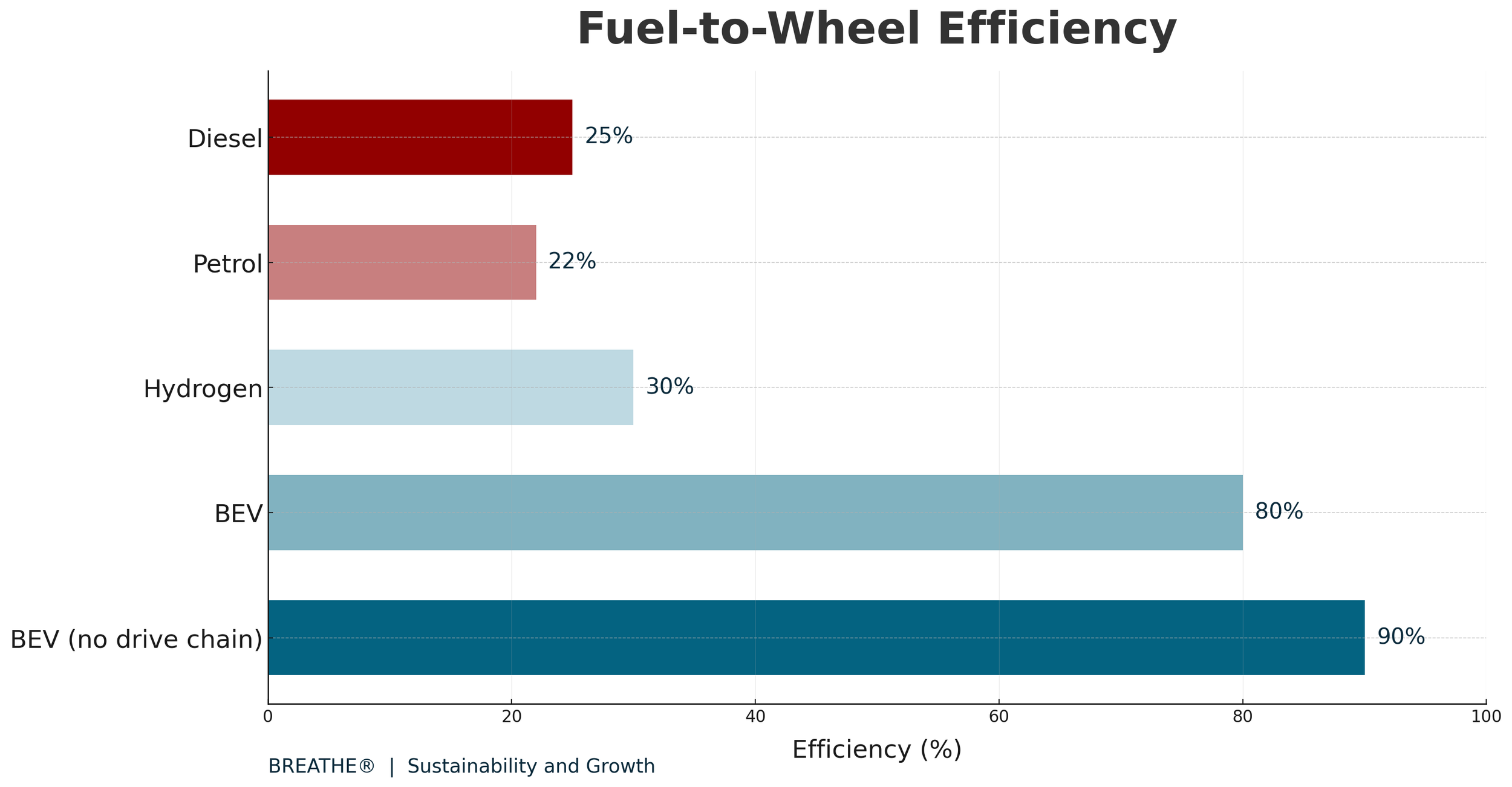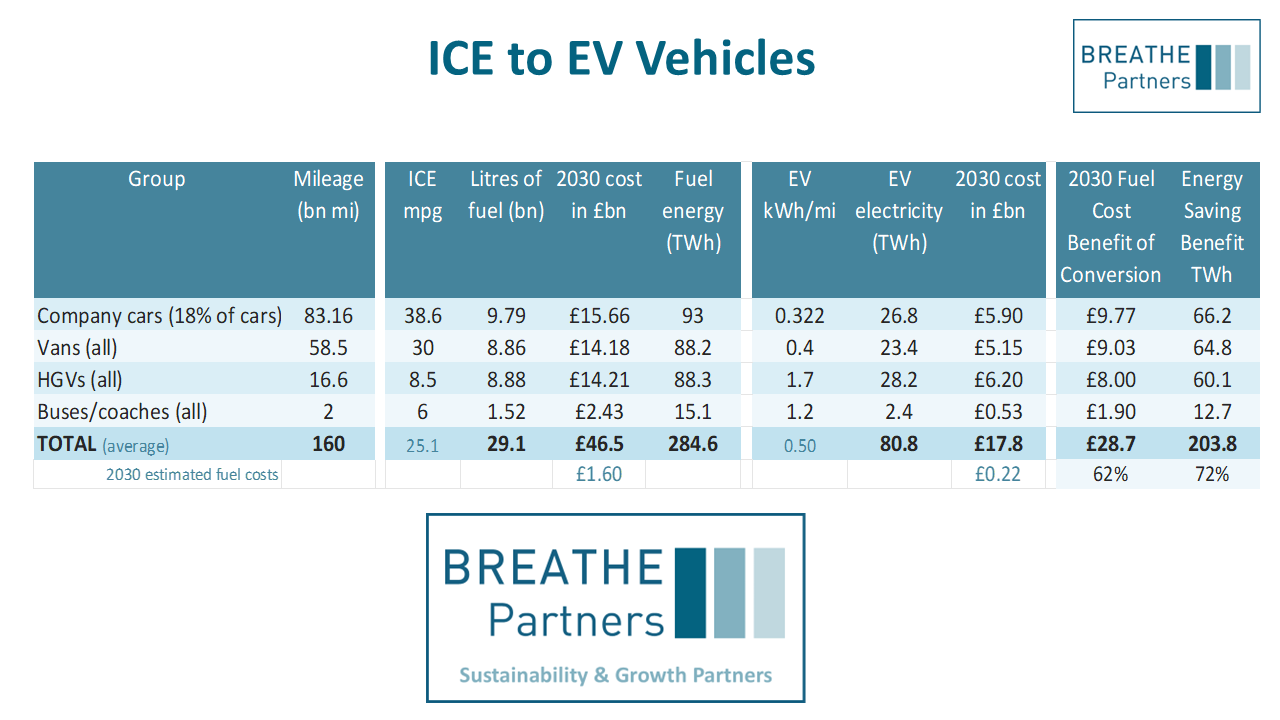
The EV Fleet £30bn Opportunity
The Electric Vehicle Fleet Revolution:
How Businesses Can Save £30 Billion and Cut Emissions by 16%
The UK’s commercial transport sector is standing at a defining moment.
Switching business fleets from petrol and diesel to electric vehicles is no longer an environmental aspiration. It is a powerful economic opportunity that can transform cost structures, improve energy resilience, and deliver measurable sustainability impact.
Breathe Partners explores how the shift to electric fleets could save UK businesses £30 billion a year at full adoption and reduce national emissions by 16 percent
The Scale of the Opportunity
There are around 42 million vehicles on UK roads, and 12 million are business-owned.
These vehicles travel roughly 160 billion miles each year, burning 29 billion litres of petrol and diesel. Internal combustion engines are only 25 to 30 percent efficient, compared with about 85 percent for electric drivetrains.
If every business vehicle switched to electric power, total energy use would fall from 285 TWh to just 81 TWh. That is a saving of 204 TWh each year. At full adoption, this reduction is worth £30 billion in annual operating costs for UK businesses
This energy reduction is equivalent to the power required to operate 41,000 large 5 GWh factories or 100,000 major distribution depots. It would also cut the UK’s carbon emissions by roughly 16 percent. That is the same as removing a mountain of carbon the size of Mont Blanc every year.
Market Growth and Policy Momentum
Electric Cars
By 2030, the UK could have around 10.8 million electric cars on the road in total. Within this total, we assume about 3.5 million will be company-owned or lease vehicles, reflecting the corporate channel’s leading role in EV uptake through Benefit-in-Kind incentives and salary sacrifice schemes.
Electric Vans
Assuming 100,000 electric vans are on the road by the end of 2025 and a 40 percent compound annual growth rate to 2030, the UK would reach about 540,000 electric vans by 2030. This reflects rapid adoption in logistics and FMCG where back-to-base charging and predictable routes create a strong operational fit.
HGVs and the Heavy Transport Challenge
The largest vehicles face the steepest climb.
All new HGVs under 26 tonnes must be zero-emission by 2035, with heavier models following by 2040. Adoption is growing from a low base. A pragmatic 2030 projection is about 2,500 electric HGVs on UK roads, scaling quickly through the 2030s as depot charging, megawatt charging systems, and vehicle availability expand
The Zero Emission HGV and Infrastructure Demonstrator (ZEHID) programme, backed by more than £200 million of government funding, is helping to de-risk this transformation by testing battery-electric and hydrogen fuel-cell trucks alongside large-scale depot infrastructure.
Why the Shift Makes Business Sense
Beyond the environmental benefits, electrifying commercial fleets is fundamentally about cost control and business resilience. Electric vehicles shield operators from volatile oil markets, simplify maintenance, and offer savings that compound over time. Overall, electric vehicles are simpler than their ICE and hydrogen counterparts, and hence much more efficient.
Unlike fossil fuels, electricity can be locally generated and increasingly renewable. With most HGVs expected to charge at depots and many company cars and vans charging at home or at work, businesses can align energy use with onsite solar, wind, or battery storage. Smart charging and vehicle-to-grid technologies reduce peaks and turn EV fleets into distributed energy assets.
The Barriers to Overcome
Electrification is not without challenges.
Upfront costs for some vehicle types remain higher than diesel or petrol equivalents
Residual values and battery lifespans are still maturing, which can affect financing and risk
Infrastructure needs are substantial, including depot upgrades, local grid capacity, and smart charging integration
Operational change is significant, covering route planning, telematics, driver training, and contingency processes
Customer sites need to support new load profiles and approved DNO connections for large-scale charging
Many businesses also face grid connection delays and complex approvals. Standardisation of hardware, payments, and smart charging systems is improving, but it is not yet complete.
These are not core competencies for most fleet-owning businesses. For many operators and procurement teams, the EV transition is unfamiliar territory. It involves technical, financial, and regulatory dimensions that are difficult to manage in-house
The Next Frontier: Autonomous and Electric Fleets
The next major transformation in commercial transport will combine electrification with autonomy.
In 2027, the UK is expected to bring into force new legislation under the Automated Vehicles Bill, creating the legal framework for self-driving commercial vehicles on public roads. This will enable controlled trials and phased deployment of autonomous fleets, including heavy goods vehicles operating on fixed logistics routes.
Autonomous driving technology complements electrification by improving efficiency, safety, and utilisation.
In the UK, driver wages and related costs typically account for 25% to 30% of total logistics expenditure, with fuel, maintenance, and vehicle financing making up most of the remainder. Removing or reducing driver costs, together with improved fuel efficiency, reduced downtime, and optimised routing, could deliver overall operating cost reductions of 50% to 60% in well-managed autonomous fleets. Some early studies suggest that in best-case scenarios, the savings could reach up to 66%.
From a regulatory perspective, the first stage will permit “self-driving capable” vehicles under human oversight by 2026, with limited commercial autonomy for logistics and delivery fleets anticipated by 2027–2028.
Wider deployment on long-haul freight corridors could follow in the early 2030s, supported by dedicated autonomous lanes and updated road-safety frameworks.
For large fleet operators, this convergence of electric and autonomous technology presents a clear opportunity.
Depots investing today in high-capacity EV charging, intelligent load management, and digital telematics will be best positioned to integrate autonomous fleets as the technology and regulation mature.
Breathe Partners continues to monitor these developments closely, supporting clients in designing future-ready electrification strategies that evolve toward autonomous operations
Navigating the Transition
The EV transition is as much about business transformation as it is about technology.
It requires independent expertise to bridge the gap between sustainability ambition and operational delivery.
That is where Breathe Partners helps.
We work alongside clients to design and implement bespoke electrification strategies that optimise cost, resilience, and carbon reduction. From assessing fleet and site readiness to modelling load profiles, installing infrastructure (onsite solar, wind, EV chargers, batteries), operating chargers, sourcing equipment, financing, and delivery planning, we guide businesses through every step and enable confident, data-driven decisions.
Partner with Breathe
Independent and objective advice focused on your business outcomes
Expertise in electrification, energy optimisation, and site infrastructure
Practical strategies that deliver measurable cost savings and sustainability impact
Partner with Breathe Partners to turn your fleet transition into a business advantage.






